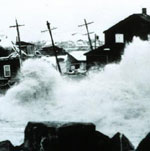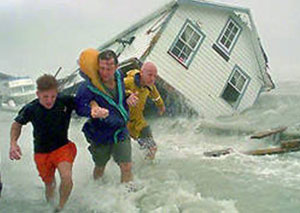
Rising seas poses a real threat to Florida Keys

FRONT PAGE
Site Search
About us

Risks to US cities
Coastal floods threaten cities
Greenhouse gas emissions
Urban ecological footprint
Cities and biodiversity
Cities at risk of flooding
Cities' future
Issues facing megacities
US built environment in 2030

Worldwide | Elections | North America | Latin America | Europe | Asia | Africa |
























US cities threatened by storms,
floods, drought and rising seas
A report by the US Natural Resources Defense Council*
28 July 2011: As the US grapples with a record year for storms, drought and weather-related devastation, a new report released by the Natural Resources Defense Council (NRDC) reveals climate change is leaving American cities open to a range of water-related vulnerabilities – from drought to sea level rise and increased rainfall – regardless of region or size. The report looks at how communities facing these new extremes are trying to protect their water supplies and waterways.
| Posed threats | Cities’ responses |
This report Thirsty for Answers: Preparing for the water-related impacts of climate change in American cities makes clear that some of the first, most profound and far-reaching impacts of climate change are water-related, affecting the water people drink, fish, and swim in. “In the future, we can expect increased violent storms, drought and rising seas, so communities nationwide, regardless of size, should get plans up and running to reduce their unique vulnerabilities and prepare for impacts,” according to Michelle Mehta, a principal author of the report
The report found that climate change would impact water supplies and waterways in communities across the US, with geography often determining the specific effects. For the first time, this peer-reviewed report has compiled the results of more than 75 scientific studies, data generated by government agencies and information gathered by other nonprofit organizations to analyze how the impacts of climate change on water supplies and waterways could affect 12 target cities:
• Boston, Massachusetts
• Chicago, Illinois
• Homer, Alaska
• Los Angeles, California
• Miami, Florida, and the Florida Keys
• New Orleans, Louisiana
• New York, New York
• Norfolk, Virginia
• Phoenix, Arizona
• San Francisco, California
• Seattle, Washington
• St. Louis, Missouri
The report provides a snapshot of projected climate change impacts in regions across the country: Rising sea levels threaten vital infrastructure and saltwater intrusion to freshwater supplies in cities on the East, West and Gulf Coasts. Severe storms in the Midwest and East Coast are likely to become more intense and more frequent, causing floods and erosion and threatening drinking water quality. In the West, a combination of increased temperatures, decreased precipitation and less snowpack contributes to a future shortage of water supply for people and aquatic life. More specifically scientific studies reveal a range of possible impacts under various carbon emission scenarios:
Posed threats
 • Rising seas: Coastal cities examined in the report, such as Miami, Norfolk, New Orleans, Los Angeles, San Francisco and Seattle are threatened by flooding and storm surges due to rising sea levels. For example, data show the very existence of the Florida Keys is at stake, with 38 per cent at risk of inundation in the most optimistic scenario. Conservative projections also suggests the California coast could see a 12- to 18-inch rise in sea levels and the coastline of Seattle a 3-to 22-inch rise relative to levels recorded in 2000.
• Rising seas: Coastal cities examined in the report, such as Miami, Norfolk, New Orleans, Los Angeles, San Francisco and Seattle are threatened by flooding and storm surges due to rising sea levels. For example, data show the very existence of the Florida Keys is at stake, with 38 per cent at risk of inundation in the most optimistic scenario. Conservative projections also suggests the California coast could see a 12- to 18-inch rise in sea levels and the coastline of Seattle a 3-to 22-inch rise relative to levels recorded in 2000.
• Saltwater intrusion also could become more common in coastal communities as a result of this sea level rise, threatening freshwater supplies, according to data compiled. In New York City, for example, saltwater is expected to journey farther up the Hudson and Delaware Rivers during high tides, two of the region’s major sources for freshwater supply. Also, the salinity problem already facing California’s Sacramento-San Joaquin River Delta is likely to increase, threatening the quality and reliability of the freshwater supply used by millions of Californians for drinking water as well as the region’s heavy agriculture industry.
• Increased storms and flooding: Research finds the Midwest is expected to experience more frequent and intense storms, contributing to the type of recent heavy flooding along the Mississippi River. The frequency of very heavy rainfall in Chicago, for example, is expected to increase by 50 per cent in the next 30 years, which without infrastructural improvements is likely to increase the number of combined sewer overflows (CSO) that send untreated sewage and storm water into the Chicago River and Lake Michigan.
• Increased rainfall along the Atlantic is predicted to cause significant flooding as a result of tropical storms nor’easters (winter storms). In New York City, 100-year floods could occur every 30 to 55 years by 2050. Such flooding increases the risk of damage to vital low-lying infrastructure in New York, as well as critical naval and civilian ports in Norfolk. Heavier rainfall in the Midwest is likely to cause increased stream flows due in part to saturated soils, threatening levees in cities like St. Louis.
• A drier West: The report describes rising temperatures, less rainfall and decreased snowpack in the US West. As a result, without proper management, water supplies could be seriously threatened in regions such as Los Angeles, Seattle and Phoenix. Slight temperature changes could cause irregular stream flow patterns and lead to unseasonal snowpack melt outside of the dry season when the runoff is most needed, the data revealed. For example, the loss of spring snowpack in California’s Sierra Nevada mountain range is highly likely, and a worst case scenario estimates stream flows in Southern California decreasing by as much as 41 per cent.
• Warmer air also could cause precipitation to fall as rain in areas where it traditionally has fallen as snow, such as in watersheds that supply the populations of Seattle and Phoenix, causing decreases and even disappearance of snowpack. Such a scenario would pose serious challenges for local water supply managers, particularly during the summer months, as they attempt to balance human demand for water with needs for water supplies for hydroelectricity and wildlife habitats.
• Decreased water quality: Data cited in the report point to the many negative effects rising carbon dioxide concentrations are having on water quality. For example, higher dissolved carbon dioxide concentrations, warmer water, and increased runoff could cause increased occurrences of harmful algal blooms in the Chesapeake Bay and around Seattle. The blooms can result in fish kills and cause shellfish to become contaminated with potent natural toxins, causing illness in humans who consume them.
Rising atmospheric carbon dioxide concentrations and warmer waters are detrimental to the health of the coral reefs off the coast of Miami and the Florida Keys, and acidification of the waters in Puget Sound near Seattle threatens shellfish, a vital contributor to the local economy.
Cities’ response
The compiled local data are cause for concern, and the report describes various steps these cities are taking to become more resilient to the effects of climate change, providing examples of steps that communities across the country should consider.
• Chicago has developed a climate action plan to reduce greenhouse gas emissions by 25 per cent below 1990 levels by 2020, and 80 per cent below 1990 levels by 2050. The plan includes steps to minimize greenhouse gas emissions and adapt to already-occurring changes in climate, while calling for improved policies on the local, state and federal levels.
• New York City has launched the Climate Change Adaption Task Force and the New York Panel on Climate Change to develop strategies to secure the city’s infrastructure in the event of floods or sea level rise.
• San Francisco, Seattle and Phoenix have taken steps to prepare for water shortages. Seattle Public Utilities has identified a series of system modifications and supply options based on research conducted by the University of Washington. It also plans to save 15 million gallons of water a day by 2030.
• Miami is working with surrounding communities to develop a strategy to prepare for rising sea levels. Four counties are working together as the Southeast Florida Regional Climate Change Compact to coordinate policy positions, scientific research and adaption efforts that ultimately will lead to a regional action plan.
• Norfolk has hired an outside consultant to conduct a flood vulnerability assessment. The firm has developed a flood forecast model that estimates flood depths based on tide elevation data. The model will allow the city to assess costs related to flood mitigation strategies, and apply the assessment to a long-term flood plan that prioritizes funding and the implementation of flood improvement projects.
*The Natural Resources Defense Council (NRDC) is an international nonprofit environmental organization with more than 1.3 million members and online activists. Since 1970, its lawyers, scientists, and other environmental specialists have worked to protect the world's natural resources, public health, and the environment.

